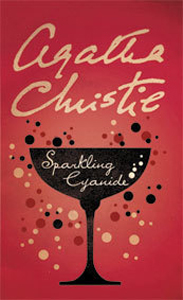“Sparkling Cyanide” (1945, also known as “Remembered Death”) was adapted twice into TV movies despite not featuring Poirot or Marple, and it’s easy to see why. Christie hits on most of her staple elements but nonetheless keeps a reader engaged till the end.
Remembering Rosemary
Part of the hook is the unusual structure. It opens with characters remembering Rosemary Barton, who died by (supposed) suicide a year earlier at a dinner party at a posh club in the countryside. The author copies this premise from her mediocre short story “Yellow Iris” (1937, collected in “The Regatta Mystery and Other Stories”), but the plot details are quite different.
Christie wisely replaces Poirot with Colonel Race and a colleague, as this is a procedural novel. The “who” and “how” are solvable by the reader; it doesn’t need Poirot’s next level of genius.

“Sparkling Cyanide” (1945)
Also published as: “Remembered Death”
Author: Agatha Christie
Series: Colonel Race No. 4
Genre: Mystery, romance
Setting: London and countryside, 1945
Still, Christie’s admiration for London’s finest is evident. There is doubt about whether Race and company will solve this case (or at least whether they’ll gather good evidence for a court case). But there’s no doubt that they’ll cross every “T” and dot every “I.”
Her interest in politics as a career, and how one climbs in the field, also shows via the Farradays.
An evident expansion
Although “Cyanide” is better than “Yellow Iris,” it’s also evident that it’s an expansion. The novel is split into three “books.” The first features remembrances, the second is set in the story’s present day and ends with a twisty surprise, and the third chronicles the investigation in earnest.
Still, the question of whether someone killed Rosemary – and if so, who – is present early in the story and late in the story. It’s a slow read because the investigators don’t make much progress. The yarn flirts with being redundant.
Christie digs so much into characters’ relationships to the late Rosemary, and their lives in general, that a reader might forget for stretches that this is a mystery.
Still, it’s definitely the characterizations – and people’s motives and opportunities to poison Rosemary’s champagne — that keep “Cyanide” from dipping to mediocrity. This is perhaps why two TV-movie adapters were drawn to this one. The shift from jovial dining and dancing to a sudden death is cinematic.
Deep background
Christie takes us deep into the backgrounds of everyone, and it’s no doubt fun to see how actors tackle the roles. Among them are the devoted but possibly jealous husband George; younger sister Iris, who would inherit wealth upon Rosemary’s death; and the aforementioned politically motivated Farradays.
More engaging than the officially recognized couples are the illicit romances. Two men might’ve had designs on Rosemary, including the mysterious Anthony Browne (if that is his real name). And a loyal secretary secretly loves Mr. Barton.

“Cyanide” is slightly overwritten: Christie is smitten with her clever structure and takes her time moving the narrative forward. The angle of approach is not standard, yet this is ultimately your basic Christie mystery with poison, detectives re-imagining the scene, and a dash of intrigue from overseas.
But it’s a strong example of Christie threading a needle: We’re equally drawn in by the characters and by a murder that seems impossible. And if you’re a fan of Race following procedure until results finally emerge, “Sparkling Cyanide” is a core entry.
Every week, Sleuthing Sunday reviews an Agatha Christie book or adaptation. Click here to visit our Agatha Christie Zone.

